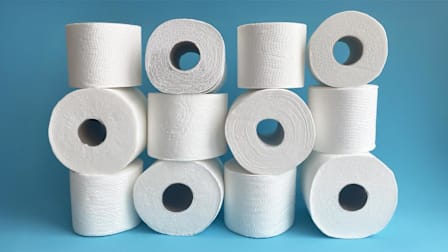You Really Should Be Cleaning Your Books
They can harbor dust and mold spores, and even develop booklice (yikes!), which can affect people with allergies and asthma

When was the last time you cleaned your books? I don’t mean half-heartedly running a duster over the spines—I mean taking a vacuum brush and maybe even a damp cloth over the sides and covers. Despite being a prolific reader (or perhaps because I’m a prolific reader), I’ll confess: I haven’t. I’m a new mom in an old house with three human occupants, one 40-pound dog, and windows that face a busy, polluted street, and I’m barely keeping up. My bookshelves, quite frankly, are shamefully dusty.
Why You Should Deep Clean Your Bookshelves—and Your Books
Dust is complex. It’s composed of dead skin cells, pollen, animal dander, dust mites, dust mite corpses, and dust mite droppings. These tiny creatures are arachnids that eat our dead skin after it falls off (thank you!) and also trigger allergies and asthma (no thank you!). Dust mites don’t sting, bite, or otherwise purposefully harm us. They are, nevertheless, unpleasant. And in some cases, they are a health hazard for folks with asthma.
PFAS, or perfluoroalkyl and polyfluoroalkyl substances, are chemicals used in consumer products that have been linked to a long list of health risks. PFAS can accumulate in household dust, according to 2022 research out of the Yale School of Public Health. This is particularly relevant for areas of the home where infants and children hang out, according to the researchers.
And while you might be regularly vacuuming your floors and laundering your linens, you shouldn’t neglect your books. Household dust, including what accumulates in the nooks and crannies of your home library, can trigger wheezing, coughing, and allergy and asthma attacks in adults and children. Booklice, insects that resemble tiny termites, can also proliferate in especially humid and mildewy conditions, and while they’re not harmful, they are disgusting.
Dead skin cells and pet hair aren’t the only contaminants coating your bookshelves in a layer of filth. “Outdoor pollutants can make their way inside, especially in older homes. In the Bay Area we see this most dramatically during wildfires,” says Michelle C. Smith, book conservator and the acting manager of the San Francisco Public Library Preservation Unit, which is hosting a Preservation Week dedicated to books and physical and digital mementos this spring. Soil, industrial chemicals, lead, and other heavy metals can be found in dust as well.
Finger oils and food can collect in and on children’s books and cookbooks, and can damage them over time. And while you might view this as inevitable—there’s simply no way I’m going to avoid getting flour and sugar on my heavily used copy of Martha Stewart’s Baking Handbook—older and more precious books may require more care to continue withstanding the test of time.
How to Clean Your Books and Keep Them Clean
Keeping your books in good condition begins with their placement. “People at home can keep their personal libraries clean and dry by not storing books near windows, vents, or radiators,” says Lindsay Laren, the assistant commissioner of collections, content, and access at the Chicago Public Library. “Storing books in basements, attics, or garages also can be damaging to books because of the temperature and humidity fluctuations that naturally happen in those spaces.” Dampness can lead to the growth of mold, but overly dry conditions can make books brittle. Position bookshelves along interior walls, as exterior walls are prone to climate fluctuations, too. According to the American Institute for Conservation of Historic & Artistic Works, keep books about an inch from the edge of the bookshelf, but don’t push them all the way back, either; air circulation will help prevent moisture, mold, and bugs that can damage books.
How often you should clean your books depends on your climate and the dust level of your home. I live in a dusty old house on a busy street and frequently keep my windows open, which allows outdoor pollution to make its way inside, so I should probably be dusting my books more frequently. The Fulton County Library in the Atlanta area recommends dusting your shelves as often as you dust the rest of your home. But “if you’re in a newer home with excellent HVAC, you might only need to vacuum dust from your books a couple of times a decade,” Smith says.
The task of cleaning the books and their shelves isn’t complicated, but it can be laborious. “For newer books in good condition, dusty top edges can be cleaned with a vacuum and brush attachment,” Smith says. “For children’s books, which have a way of getting sticky, glossy printed covers can be wiped down with a damp cloth.” But test a small area first. Book spines can be vacuumed or wiped with a soft cloth, according to the New York Public Library. For delicate books, you can affix cheesecloth to the end of a vacuum, according to the American Institute for Conservation of Historic & Artistic Works. This can catch any pieces that might chip off the book while cleaning.
And to avoid this entire affair almost entirely—and this one sounds appealing to me, as someone with a penchant for accumulating novels—consider bookshelves with glass doors. Then your primary area of focus will be cleaning any crevices on the cabinet exterior, a considerably quicker task than cleaning the tops and sides of each shelf.




















